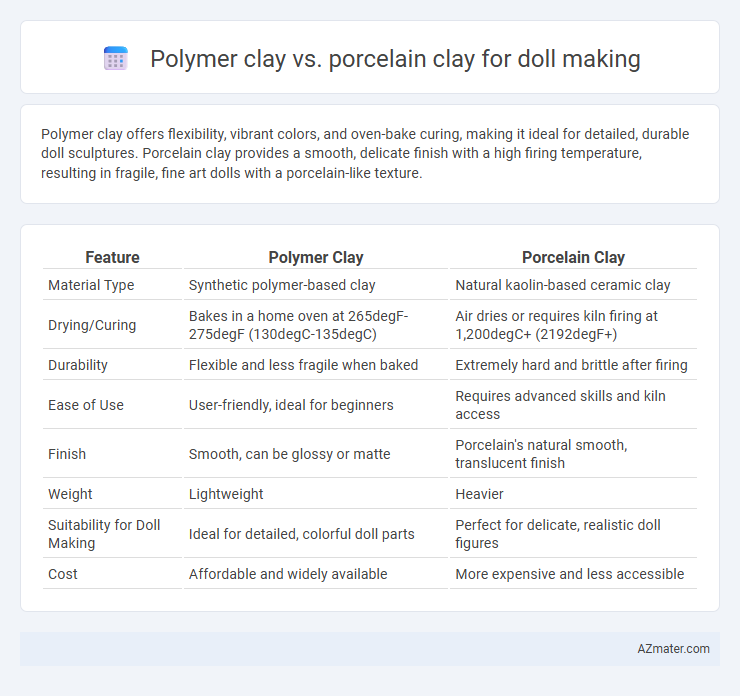Polymer clay offers flexibility, vibrant colors, and oven-bake curing, making it ideal for detailed, durable doll sculptures. Porcelain clay provides a smooth, delicate finish with a high firing temperature, resulting in fragile, fine art dolls with a porcelain-like texture.
Table of Comparison
| Feature | Polymer Clay | Porcelain Clay |
|---|---|---|
| Material Type | Synthetic polymer-based clay | Natural kaolin-based ceramic clay |
| Drying/Curing | Bakes in a home oven at 265degF-275degF (130degC-135degC) | Air dries or requires kiln firing at 1,200degC+ (2192degF+) |
| Durability | Flexible and less fragile when baked | Extremely hard and brittle after firing |
| Ease of Use | User-friendly, ideal for beginners | Requires advanced skills and kiln access |
| Finish | Smooth, can be glossy or matte | Porcelain's natural smooth, translucent finish |
| Weight | Lightweight | Heavier |
| Suitability for Doll Making | Ideal for detailed, colorful doll parts | Perfect for delicate, realistic doll figures |
| Cost | Affordable and widely available | More expensive and less accessible |
Introduction to Doll-Making Clays
Polymer clay and porcelain clay are two popular materials in doll making, each offering distinct properties and benefits. Polymer clay is a versatile, synthetic medium that cures at low temperatures, allowing for vibrant colors and detailed sculpting with ease. Porcelain clay, a traditional ceramic material, requires kiln firing and provides a delicate, smooth finish ideal for collectible, high-end dolls.
What is Polymer Clay?
Polymer clay is a versatile synthetic modeling material composed primarily of polyvinyl chloride (PVC) resins, plasticizers, and pigments, allowing for vibrant colors and detailed sculpting in doll making. It cures through a low-temperature baking process, typically between 265degF and 275degF (129degC to 135degC), resulting in a durable, lightweight, and slightly flexible finish ideal for intricate doll features. Compared to porcelain clay, polymer clay offers greater ease of use, faster curing times, and enhanced resistance to breakage, making it a preferred medium for both beginners and professional doll artists.
What is Porcelain Clay?
Porcelain clay is a fine, high-quality ceramic material known for its smooth texture and durability, often used in doll making to achieve a delicate, lifelike finish. Unlike polymer clay, which is a synthetic, oven-baked medium, porcelain clay requires kiln firing to harden and develops a translucent, porcelain-like surface. Its ability to capture intricate details and retain a cool, smooth touch makes porcelain clay ideal for premium, collectible dolls.
Workability: Ease of Sculpting
Polymer clay offers exceptional workability due to its pliability and longer open time, allowing detailed sculpting and easy adjustments before baking. Porcelain clay, while providing a smooth, fine texture ideal for delicate features, requires more skill to shape as it is less forgiving and hardens quickly during drying and firing. Sculptors favor polymer clay for beginners and intricate designs, whereas porcelain clay suits experienced artists seeking a refined, traditional finish.
Durability and Strength Comparison
Polymer clay offers superior durability and flexibility, making it resistant to cracking and breaking during handling and play, while porcelain clay is more fragile and prone to chipping or shattering upon impact. Porcelain clay provides a smooth, porcelain-like finish but requires careful firing at high temperatures to achieve its strength, unlike air-dry or oven-baked polymer clay which cures at lower temperatures. In terms of long-term structural integrity, polymer clay is favored for its resilience and ease of repair, whereas porcelain demands more delicate care and maintenance.
Finishing Techniques and Surface Detail
Polymer clay offers versatile finishing techniques such as sanding, buffing, and baking to achieve smooth, durable surfaces ideal for detailed doll features, while porcelain clay requires careful firing and glazing to enhance its translucent and delicate texture. Surface detail on polymer clay can be finely sculpted and maintained through curing, allowing for intricate designs and painting with acrylics or varnishes for added realism. Porcelain clay's surface captures crisp, refined details with a natural matte or glossy finish post-firing, demanding precision in handling to prevent cracking or blemishes during the drying and kiln process.
Firing and Curing Processes
Polymer clay cures through baking at low temperatures, typically around 265degF to 275degF (130degC), in a conventional oven, making it accessible for home use without specialized kilns. Porcelain clay requires firing in a kiln at much higher temperatures, between 1,830degF to 2,372degF (1,000degC to 1,300degC), resulting in a vitrified, durable, and translucent finish. The significant difference in firing and curing processes affects both the structural integrity and finishing techniques of dolls made from these materials.
Color Options and Painting Compatibility
Polymer clay offers an extensive range of vibrant color options, allowing artists to create detailed, multicolored dolls without the need for additional painting. Porcelain clay, typically white or off-white, requires painting after firing to achieve desired hues and intricate designs, providing a smooth surface that enhances paint adhesion and finish quality. While polymer clay's built-in coloration simplifies the process, porcelain clay's painting compatibility offers greater flexibility for fine art detailing and customized color effects.
Cost and Availability
Polymer clay is generally more affordable and widely available in craft stores and online, making it a cost-effective choice for doll making. Porcelain clay tends to be more expensive due to its specialized materials and is often limited to art supply shops or ceramics studios. The accessibility of polymer clay contributes to its popularity among hobbyists, while porcelain clay is preferred by professionals seeking a high-quality, durable finish.
Which Clay is Best for Your Doll Project?
Polymer clay offers vibrant colors, flexibility, and durability, making it ideal for detailed and lightweight doll projects that require baking to harden. Porcelain clay provides a smooth, delicate finish with a classic, elegant look but demands kiln firing and is more fragile after firing compared to polymer clay. Choosing between polymer and porcelain clay depends on your project's need for durability, detail, and the available firing method, with polymer clay best for versatile, low-maintenance dolls and porcelain suitable for fine, collectible art dolls.

Infographic: Polymer clay vs Porcelain clay for Doll making
 azmater.com
azmater.com